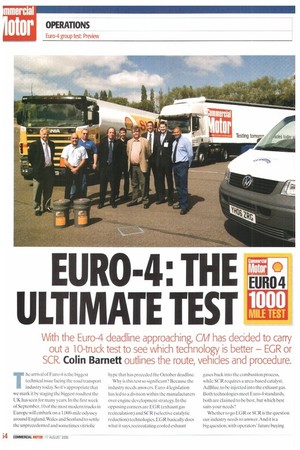EURO-4: THE ULTIMATE TEST
Page 54

Page 56

If you've noticed an error in this article please click here to report it so we can fix it.
With the Euro-4 deadline approaching, CM has decided to carry
out a 10-truck test to see which technology is better — EGR or
SCR. Colin Barnett outlines the route, vehicles and procedure.
The arrival of Euro-4 is the biggest technical issue facing the road transport industry today. So it's appropriate that we mark it by staging the biggest roadtest the UK has seen for many years. In the first week of September, 10 of the most modern trucks in Europe will embark on a 1,000-mile odyssey around England,Wales and Scotland to settle the unprecedented and sometimes vitriolic hype that has preceded the October deadline.
Why is this test so significant? Because the industry needs answers. Euro-4 legislation has led to a division within the manufacturers over engine development strategy In the opposing corners are EGR (exhaust gas recirculation) and SCR (selective catalytic reduction) technologies. EGR basically does what it says, recirculating cooled exhaust gases back into the combustion process, while SCR requires a urea-based catalyst, AdBlue. to be injected into the exhaust gas. Both technologies meet Euro-4 standards, both are claimed lobe best, but which best suits your needs'?
Whether to go EGR or SCR is the question our industry needs to answer. And it is a big question, with operators' future buying strategies in the balance. Some have already decided on their option, and some have already decided to move directly to Euro5, willing to pay a premium for enhanced residual values.
But most are waiting for more information, either from their suppliers or independent testing — which is where we come in.
Following the initial idea, Shell Lubricants quickly came on board to offer itself as the principal sponsor for the test. An inaugural meeting was held at Shell's London headquarters in February, attended by all seven of the major European truck makers.
It was crucial to convince the manufacturers that the test would be conducted in a fair and equitable way; Everything possible has been done io eliminate variable factors.There has been an unprecedented level of consultation with the truck makers to answer their concerns. One by one, all seven brands agreed to participate. Two classes will be run,for 40 and 44 tonnes, with manufacturers able to enter either or both classes.
Four-day route
The test will take place at the beginning of September, over a gruelling four-day route covering just over 1 ,000 miles. It was originally planned to visit the three capitals on the mainland, but common sense prevailed in respect of driving anywhere near London. So, from the start at Millbrook (see panel), the trucks will head across country to pick up the M4 at Newbury, then make for the first overnight halt at Cardiff.
Day two sees them tackling the A-roads up through the centre of Wales before a break at Shell's Stanlow refinery on the Wirral.Then it's motorway to Gretna for the second night.
Day three takes in Glasgow and Edinburgh before the challenge of the old CM route down the A68 and on to join the A I M south of Durham, and a final night out near Scotch Corner.
The last day comprises a relatively easy run back down the motorways to Mill brook.
Each truck will be driven by a manufacturerappointed driver, accompanied by an independent observer from CM.The observers, who will rotate among the trucks, will navigate, keep time and fuel records, and generally monitor the drive. All traffic rules, including speed and driving hours, will be strictly enforced.
Burden of proof
The manufacturers have been asked to submit 'standard specification' vehicles and declare any additional optional specification available on the production line.They have also been asked to submit a 'letter of authenticity' signed by the sales director and submit documentation proving that the vehicle submitted is the vehicle on test. Pre-test checking will confirm this, as well as closely monitoring gross weights and tyre pressures.
Shell Lubricants is providing the Rimula Signia 10W-40 engine oil that will be used by every contenderThe all-important fuel for the test is also being provided by Shell, with fuel and Adl3lue tanks sealed by an independent adjudicator who will accompany the test throughout.
One of the biggest issues in the war of words is the combined fuel and AdBlue cost for the SCR vehicles, so the results will show a total combined fuel/AdBlue cost per I 00krn.They will be revealed in CM on 28 September, days before Euro-4 comes into force. •










































































































































































































